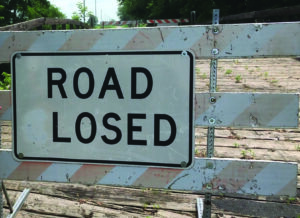
Aug 26, 2020
by Carl Greene
Executive Director
When my family and I moved to Wisconsin, I wanted to check out our local post office. So, I drove down this road on the way there and got to a sign which read, “Road Closed.” I got out of my vehicle and sat down in front of that sign, and I wept, and have sat there ever since.
I hope that’s not the story, right? I had to turn around and find a different way.
I took similar roads—just a different path to get to where I needed to be. This “Road Closed” idea makes me think of the early church in the book of Acts. Time and time again, the early church face a road closed sign. They sense God’s calling in a specific way, they start moving in that direction, but then there’s disruption. Something takes place—a jailing, a catastrophe, some sort of natural disaster—something takes place that interrupts the plans, but then they realize an opportunity to join God in His work in a dramatic way. I think the same is true for us over this past year, isn’t it? It didn’t always feel like “Road Closed”—many times over the past year it felt like “Road Losed.”
I don’t know how it was for you, but although the road was closed, there was still tremendous opportunity. A year ago, at a General Conference session, I talked about our vision as a Conference to partner with local churches to actively advance God’s Kingdom, and we do that through church revitalization, leadership development, gospel saturation, and church planting. And you know, we have used those roads throughout this past year, but it’s been a different journey amidst uncertainty and disruption. What I want to talk about with you now is, what is the road that we’re on? Now that we’ve faced a number of “Road Closed” signs, where are we heading as a General Conference?
One of the roads that we’re on is the road of church revitalization—the vision of healthy churches. With the road closed season of COVID-19, our picture of how a healthy church functions pivoted. In that time period, we have continued to adapt—and in many ways, prune—to be prepared for a new normal. When I think of pruning, usually I think of pruning of dead branches, or sick branches; not so much the idea of pruning off healthy things to be shaped for what’s next. But that’s the season we’re in: pruning forward, in which we have to take a look at how we prepare for what’s coming. This pruning forward idea is something that we’ve really leaned into with church revitalization this year.
I’m so thrilled to partner with the Seventh Day Baptist Memorial Board in providing church revitalization grants—grants that are used by local churches to be able to pivot in this season, using the grant money for technology upgrades, for community outreach in unique ways, or for looking at emotional and spiritual health of the church. These grants have been fantastic in providing church revitalization opportunities in this pruning forward season. If your church hasn’t yet participated in this, I would really encourage you to apply for these $1,000 grants to help during this season of pruning forward.
When it comes to church revitalization, there’s also our ongoing process of Pulse. Pulse is the church revitalization process that has been ongoing. A number of SDB churches have been participating in this process, and now all the more is a great season to participate. John Pethtel, Director of Church Development, leads this process, and it is fantastic. This is an opportunity for the church to look at clarity, movement, alignment and focus when it comes to mission. Now, Pulse also provides facilitators to help serve as a catalyst in this conversation in your church. So, if you haven’t yet engaged in Pulse, please contact John Pethtel.
So, there’s the road of church revitalization and also, there’s the road of leadership development. Leadership development is really focused on the health of leaders. When I think of health, I think of kale. How can you go wrong with kale? …There are lots of ways you can go wrong with kale. But hold on to the health idea. When it comes to healthy leaders, we have looked specifically at ways of coming alongside of pastors, their families, and leaders during this time. Specifically, we have partnered with some grant partners—with the Baptist World Alliance and with the National Association of Evangelicals. We’ve also partnered with generous donations given by wonderful people for many grants to be able to provide for emotional, spiritual, physical, and financial needs of pastors. We have raised about $15,000 to provide these mini-grants to pastors during this season. I’m also really thankful for the Women’s Society’s ongoing support of healthy leaders—specifically, the advocacy of President Jenni Wangsness and the use of the Stephanie Sholtz Wellness Fund.
We are in a season of nurturing healthy leaders. Now, part of leadership development is also longer ranged—of training leaders for the future, and this comes down to SDBU. Nick Kersten, Director of Education and History, has led the charge in this
initiative, which continues to increase in enrollment for the Ministry Leadership Certificate. This fall is the rollout of the Pastor Leadership Certificate. We are training leaders to be prepared for tomorrow. We are proactively engaging in this, and in this season
in which online learning has really taken root and exploded, we are ready for this. One of the key pieces is that there is training of young leaders by veteran leaders. Veteran pastors, veteran leaders, are doing the training, in which they are able to be sharpened while they’re teaching. What a great opportunity for education!
One of the roads that we’re on is gospel saturation. This idea of gospel saturation refers to sharing the good news of Jesus Christ in all that we say and do. In many ways, it requires us to put on our glasses to be able to observe and see the opportunities to share our faith which God is bringing us in this season. Now, in this season of “Road Closed,” how the opportunities have shifted and pivoted! Thank you to the Evangelism Task Force for moving us into this virtual space of being able to share faith. They connected us with Amplify Conference virtually. The Evangelism Task Force has provided lots of resources and Zoom meetings, and all sorts of ways for individuals and churches to engage in gospel saturation.
I want to point out that this idea of seeing opportunities is in all that we say and do. There’s a need for us to take a look at the glasses that we look at things through. What are our blind spots? Where are places as a Conference where we’re not living out the gospel? One of the spaces that we’re looking at is a culture audit—looking at how we live out our life as a Conference with diversity. I am so thankful to be able to partner with Andy Samuels, the Chief Executive Director of the Seventh Day Baptist Missionary Society, and the team of individuals to do this culture audit. Another way that we’re taking a look at opportunities that we might be missing is being ready for future crises. We’ve put together a Crisis Management Team. I’m thankful for John Pethtel’s leadership in this, in which we’re prepared and ready as moments of crisis come to be able to respond in a timely way and to continue on the road of gospel saturation. Now this saturation goes along with the gospel, in which we are looking to immerse our communication. And, communication has pivoted a lot this year! Thank you to Jeremiah Owen, Director of Seventh Day Baptist Communication, for leading us in this effort. We’ve moved into increasing our blog presence, of Zoom forums, of Facebook Live, of virtual church visits, of doing video messages each week, of doing a virtual Conference—all sorts of ways in which our reach has increased by seeing the opportunities of this season. I am also so thankful for this saturation provided by our traditional publications—for Pat Cruzan, editor of the Sabbath Recorder, of leaning into the themes of our mission as a General Conference; for Steve Osborn, editor of the Helping Hand, to be able to take a look at and be prepared to engage in some incredibly timely themes this year. I’m also thankful for Jeremiah Owen for his editing the newsletter sent out by the General Conference in which we look at each of these roads specifically and communicate what we’re doing.
This road of gospel saturation really runs parallel with our road of church planting. Church planting is deeply linked with healthy churches and healthy leaders, so this is an ongoing process; we can’t miss the fact that this is a process that is being built upon. So this year we’ve spent a lot of time looking at our structure, of how it is that we’re prepared with financial and human resources to lean into this space all the more. I’m very thankful for Patty Petersen coming on as the Church Planting Coordinator and working with new contacts. I’m incredibly thankful for John Pethtel, Director of Church Development, to continue leaning into this space. We’ve had a great partnership with the Seventh Day Baptist Memorial Board in being able to provide grants to start-up groups. But even as we continue to adjust, even as we continue to put more emphasis in this area, we need to be honest—there are distractions.
There is a danger that we are crisis-driven rather than mission-motivated. We need to be prepared for distractions. When it comes to church planting, we can keep talking about it, but as soon as a distraction comes, we take our eyes off it and move in other directions. This is a road that requires intentionality, of continuing to zero in on moving forward. I’ve talked about four different roads, and we really have an option moving forward. When we get to the road closed sign, do we sit down and say that this is a road losed? Or do we see this as an opportunity to join God in His work in unique ways? This year ahead, as we take these four roads, I am enthusiastic about where God is leading us—that even though there will undoubtably be more disruptions, there is a mighty work that God is inviting us to join Him in. I hope we are ready—no, we are ready—together.


